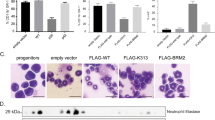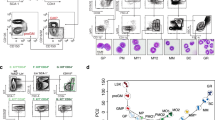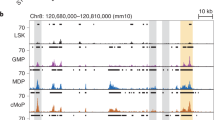Abstract
During 'emergency' situations such as infections, host defense requires rapid mobilization of bone marrow granulocyte progenitors. 'Steady-state' granulopoiesis is absolutely dependent on the C/EBPα transcription factor, but the transcriptional mechanisms underlying emergency granulopoiesis remain unclear. Here we show that large numbers of granulocytes were generated from C/EBPα-deficient progenitors after cytokine stimulation in vivo. Cytokine treatment or fungal infection induced upregulation of C/EBPβ but not C/EBPα or C/EBPε transcripts in granulocyte progenitors, and C/EBPβ-deficient progenitors showed decreased emergency-induced granulopoiesis in vitro and in vivo. C/EBPβ inhibited proliferation less severely than did C/EBPα. These data suggest a critical function for C/EBPβ in emergency granulopoiesis, which demands both differentiation and proliferation of granulocyte precursors.
This is a preview of subscription content, access via your institution
Access options
Subscribe to this journal
Receive 12 print issues and online access
$209.00 per year
only $17.42 per issue
Buy this article
- Purchase on Springer Link
- Instant access to full article PDF
Prices may be subject to local taxes which are calculated during checkout







Similar content being viewed by others
References
Metcalf, D. Control of granulocytes and macrophages: molecular, cellular, and clinical aspects. Science 254, 529–533 (1991).
Tenen, D.G., Hromas, R., Licht, J.D. & Zhang, D.E. Transcription factors, normal myeloid development, and leukemia. Blood 90, 489–519 (1997).
Zhu, J. & Emerson, S.G. Hematopoietic cytokines, transcription factors and lineage commitment. Oncogene 21, 3295–3313 (2002).
Cheers, C. et al. Production of colony-stimulating factors (CSFs) during infection: separate determinations of macrophage-, granulocyte-, granulocyte-macrophage-, and multi-CSFs. Infect. Immun. 56, 247–251 (1988).
Watari, K. et al. Serum granulocyte colony-stimulating factor levels in healthy volunteers and patients with various disorders as estimated by enzyme immunoassay. Blood 73, 117–122 (1989).
Metcalf, D. & Nicola, N.A. Proliferative effects of purified granulocyte colony-stimulating factor (G-CSF) on normal mouse hemopoietic cells. J. Cell. Physiol. 116, 198–206 (1983).
Liu, F., Wu, H.Y., Wesselschmidt, R., Kornaga, T. & Link, D.C. Impaired production and increased apoptosis of neutrophils in granulocyte colony-stimulating factor receptor-deficient mice. Immunity 5, 491–501 (1996).
Lieschke, G.J. et al. Mice lacking granulocyte colony-stimulating factor have chronic neutropenia, granulocyte and macrophage progenitor cell deficiency, and impaired neutrophil mobilization. Blood 84, 1737–1746 (1994).
Metcalf, D. et al. Effects of purified bacterially synthesized murine multi-CSF (IL-3) on hematopoiesis in normal adult mice. Blood 68, 46–57 (1986).
Metcalf, D. et al. Hemopoietic responses in mice injected with purified recombinant murine GM-CSF. Exp. Hematol. 15, 1–9 (1987).
Nishinakamura, R. et al. Mice deficient for the IL-3/GM-CSF/IL-5 β c receptor exhibit lung pathology and impaired immune response, while β IL3 receptor-deficient mice are normal. Immunity 2, 211–222 (1995).
Landschulz, W.H., Johnson, P.F. & McKnight, S.L. The DNA binding domain of the rat liver nuclear protein C/EBP is bipartite. Science 243, 1681–1688 (1989).
Smith, L.T., Hohaus, S., Gonzalez, D.A., Dziennis, S.E. & Tenen, D.G.P.U. 1 (Spi-1) and C/EBPα regulate the granulocyte colony-stimulating factor receptor promoter in myeloid cells. Blood 88, 1234–1247 (1996).
Ford, A.M. et al. Regulation of the myeloperoxidase enhancer binding proteins Pu1, C-EBPα, -β and -δ during granulocyte-lineage specification. Proc. Natl. Acad. Sci. USA 93, 10838–10843 (1996).
Oelgeschlager, M., Nuchprayoon, I., Luscher, B. & Friedman, A.D. C/EBP, c-Myb, and PU.1 cooperate to regulate the neutrophil elastase promoter. Mol. Cell. Biol. 16, 4717–4725 (1996).
Radomska, H.S. et al. CCAAT/enhancer binding protein α is a regulatory switch sufficient for induction of granulocytic development from bipotential myeloid progenitors. Mol. Cell. Biol. 18, 4301–4314 (1998).
Zhang, D.E. et al. Absence of granulocyte colony-stimulating factor signaling and neutrophil development in CCAAT enhancer binding protein α-deficient mice. Proc. Natl. Acad. Sci. USA 94, 569–574 (1997).
Zhang, P. et al. Enhancement of hematopoietic stem cell repopulating capacity and self-renewal in the absence of the transcription factor C/EBPα. Immunity 21, 853–863 (2004).
Yamanaka, R. et al. Impaired granulopoiesis, myelodysplasia, and early lethality in CCAAT/enhancer binding protein ε-deficient mice. Proc. Natl. Acad. Sci. USA 94, 13187–13192 (1997).
Natsuka, S. et al. Macrophage differentiation-specific expression of NF-IL6, a transcription factor for interleukin-6. Blood 79, 460–466 (1992).
Scott, L.M., Civin, C.I., Rorth, P. & Friedman, A.D. A novel temporal expression pattern of three C/EBP family members in differentiating myelomonocytic cells. Blood 80, 1725–1735 (1992).
Screpanti, I. et al. Lymphoproliferative disorder and imbalanced T-helper response in C/EBPβ-deficient mice. EMBO J. 14, 1932–1941 (1995).
Tanaka, T. et al. Targeted disruption of the NF-IL6 gene discloses its essential role in bacteria killing and tumor cytotoxicity by macrophages. Cell 80, 353–361 (1995).
Sterneck, E., Tessarollo, L. & Johnson, P.F. An essential role for C/EBPβ in female reproduction. Genes Dev. 11, 2153–2162 (1997).
Sterneck, E. et al. Selectively enhanced contextual fear conditioning in mice lacking the transcriptional regulator CCAAT/enhancer binding protein δ. Proc. Natl. Acad. Sci. USA 95, 10908–10913 (1998).
Zhang, P. et al. Upregulation of interleukin 6 and granulocyte colony-stimulating factor receptors by transcription factor CCAAT enhancer binding protein α (C/EBPα) is critical for granulopoiesis. J. Exp. Med. 188, 1173–1184 (1998).
Collins, S.J., Ulmer, J., Purton, L.E. & Darlington, G. Multipotent hematopoietic cell lines derived from C/EBPα−/− knockout mice display granulocyte macrophage-colony-stimulating factor, granulocyte-colony-stimulating factor, and retinoic acid-induced granulocytic differentiation. Blood 98, 2382–2388 (2001).
Liu, F., Song, Y. & Liu, D. Hydrodynamics-based transfection in animals by systemic administration of plasmid DNA. Gene Ther. 6, 1258–1266 (1999).
Niwa, H., Yamamura, K. & Miyazaki, J. Efficient selection for high-expression transfectants with a novel eukaryotic vector. Gene 108, 193–199 (1991).
Jiang, J., Yamato, E. & Miyazaki, J. Intravenous delivery of naked plasmid DNA for in vivo cytokine expression. Biochem. Biophys. Res. Commun. 289, 1088–1092 (2001).
Akashi, K., Traver, D., Miyamoto, T. & Weissman, I.L. A clonogenic common myeloid progenitor that gives rise to all myeloid lineages. Nature 404, 193–197 (2000).
Wang, N.D. et al. Impaired energy homeostasis in C/EBPα knockout mice. Science 269, 1108–1112 (1995).
Zhang, P. et al. Induction of granulocytic differentiation by 2 pathways. Blood 99, 4406–4412 (2002).
Basu, S. et al. “Emergency” granulopoiesis in G-CSF-deficient mice in response to Candida albicans infection. Blood 95, 3725–3733 (2000).
Begay, V., Smink, J. & Leutz, A. Essential requirement of CCAAT/enhancer binding proteins in embryogenesis. Mol. Cell. Biol. 24, 9744–9751 (2004).
Sutherland, J.A., Turner, A.R., Mannoni, P., McGann, L.E. & Turc, J.M. Differentiation of K562 leukemia cells along erythroid, macrophage, and megakaryocyte lineages. J. Biol. Response Mod. 5, 250–262 (1986).
Duprez, E., Wagner, K., Koch, H. & Tenen, D.G. C/EBPβ: a major PML-RARA-responsive gene in retinoic acid-induced differentiation of APL cells. EMBO J. 22, 5806–5816 (2003).
Ross, S.E. et al. Phosphorylation of C/EBPα inhibits granulopoiesis. Mol. Cell. Biol. 24, 675–686 (2004).
Wang, Q.F., Cleaves, R., Kummalue, T., Nerlov, C. & Friedman, A.D. Cell cycle inhibition mediated by the outer surface of the C/EBPα basic region is required but not sufficient for granulopoiesis. Oncogene 22, 2548–2557 (2003).
Johansen, L.M. et al. c-Myc is a critical target for c/EBPα in granulopoiesis. Mol. Cell. Biol. 21, 3789–3806 (2001).
Descombes, P., Chojkier, M., Lichtsteiner, S., Falvey, E. & Schibler, U. LAP, a novel member of the C/EBP gene family, encodes a liver-enriched transcriptional activator protein. Genes Dev. 4, 1541–1551 (1990).
Poli, V., Mancini, F.P. & Cortese, R. IL-6DBP, a nuclear protein involved in interleukin-6 signal transduction, defines a new family of leucine zipper proteins related to C/EBP. Cell 63, 643–653 (1990).
Akira, S. et al. A nuclear factor for IL-6 expression (NF-IL6) is a member of a C/EBP family. EMBO J. 9, 1897–1906 (1990).
Wang, Q.F. & Friedman, A.D. CCAAT/enhancer-binding proteins are required for granulopoiesis independent of their induction of the granulocyte colony-stimulating factor receptor. Blood 99, 2776–2785 (2002).
Popernack, P.M., Truong, L.T., Kamphuis, M. & Henderson, A.J. Ectopic expression of CCAAT/enhancer binding protein beta (C/EBPβ) in long-term bone marrow cultures induces granulopoiesis and alters stromal cell function. J. Hematother. Stem Cell Res. 10, 631–642 (2001).
Jones, L.C. et al. Expression of C/EBPβ from the C/ebpα gene locus is sufficient for normal hematopoiesis in vivo. Blood 99, 2032–2036 (2002).
Trautwein, C. et al. Transactivation by NF-IL6/LAP is enhanced by phosphorylation of its activation domain. Nature 364, 544–547 (1993).
Buck, M., Poli, V., van der Geer, P., Chojkier, M. & Hunter, T. Phosphorylation of rat serine 105 or mouse threonine 217 in C/EBPβ is required for hepatocyte proliferation induced by TGFα. Mol. Cell 4, 1087–1092 (1999).
Hsu, C.L. et al. Antagonistic effect of CCAAT enhancer-binding protein-α and Pax5 in myeloid or lymphoid lineage choice in common lymphoid progenitors. Proc. Natl. Acad. Sci. USA 103, 672–677 (2006).
McKnight, S.L. McBindalla–better name for CCAAT/enhancer binding proteins? Cell 107, 259–261 (2001).
Wang, H. et al. C/EBPα arrests cell proliferation through direct inhibition of Cdk2 and Cdk4. Mol. Cell 8, 817–828 (2001).
Porse, B.T. et al. E2F repression by C/EBPα is required for adipogenesis and granulopoiesis in vivo. Cell 107, 247–258 (2001).
Xie, H., Ye, M., Feng, R. & Graf, T. Stepwise reprogramming of B cells into macrophages. Cell 117, 663–676 (2004).
Greenbaum, L.E. et al. CCAAT enhancer-binding protein β is required for normal hepatocyte proliferation in mice after partial hepatectomy. J. Clin. Invest. 102, 996–1007 (1998).
Nerlov, C. C/EBPα mutations in acute myeloid leukaemias. Nat. Rev. Cancer 4, 394–400 (2004).
Pabst, T. et al. AML1-ETO downregulates the granulocytic differentiation factor C/EBPα in t(8;21) myeloid leukemia. Nat. Med. 7, 444–451 (2001).
Perrotti, D. et al. BCR-ABL suppresses C/EBPα expression through inhibitory action of hnRNP E2. Nat. Genet. 30, 48–58 (2002).
Guibal, F., Radomska, H.S., Johansen, L.M. & Tenen, D.G. C/EBP is deregulated by PML-RAR in acute promyelocytic leukemia. Blood 106, 844 (2005).
Radomska, H.S. et al. Block of C/EBPα function by phosphorylation in acute myeloid leukemia with FLT3 activating mutations. J. Exp. Med. 203, 371–381 (2006).
Morita, S., Kojima, T. & Kitamura, T. Plat-E: an efficient and stable system for transient packaging of retroviruses. Gene Ther. 7, 1063–1066 (2000).
Acknowledgements
We thank S. Elf, M.E. Guiney and K. Martens for assistance in animal husbandry; J. Yang and R. Hanson for assistance in procuring Cebpb−/− mice; L. Prickett for cell sorting; and G. Huang, S. Kobayashi, A. Kawasaki, D.A. Gonzalez, H. Iwasaki and all other members of the laboratories of D.G.T. and K.A. for discussions and suggestions. Supported by the National Institutes of Health (HL56745 to D.G.T.).
Author information
Authors and Affiliations
Corresponding author
Ethics declarations
Competing interests
The authors declare no competing financial interests.
Supplementary information
Supplementary Fig. 1
Serum cytokine concentrations after hydrodynamics-mediated gene transfer (PDF 88 kb)
Supplementary Fig. 2
Functional analysis of BM progenitors with or without cytokine treatment in vivo. (PDF 42 kb)
Supplementary Fig. 3
Rescue of granulopoiesis in Cebpaf/f conditional knockout mice by cytokine treatments. (PDF 97 kb)
Supplementary Fig. 4
Cebpb−/− progenitors demonstrate reduced proliferative potential in vitro (PDF 653 kb)
Supplementary Fig. 5
K562 cell lines stably expressing ER proteins fused to C/EBPα or C/EBPβ. (PDF 869 kb)
Supplementary Fig. 6
Effects of C/EBPα and C/EBPβ on cell cycle status of BAF and 32D cell lines (PDF 459 kb)
Supplementary Table 1
Differential counts of methylcellulose colony assay. (PDF 49 kb)
Supplementary Table 2
Primers and probes for quantitative PCR. (PDF 76 kb)
Rights and permissions
About this article
Cite this article
Hirai, H., Zhang, P., Dayaram, T. et al. C/EBPβ is required for 'emergency' granulopoiesis. Nat Immunol 7, 732–739 (2006). https://doi.org/10.1038/ni1354
Received:
Accepted:
Published:
Issue Date:
DOI: https://doi.org/10.1038/ni1354
This article is cited by
-
Effects of Dopamine on stem cells and its potential roles in the treatment of inflammatory disorders: a narrative review
Stem Cell Research & Therapy (2023)
-
The RNA m6A demethylase ALKBH5 drives emergency granulopoiesis and neutrophil mobilization by upregulating G-CSFR expression
Cellular & Molecular Immunology (2023)
-
Neutrophil sub-types in maintaining immune homeostasis during steady state, infections and sterile inflammation
Inflammation Research (2023)
-
Myeloid-derived suppressor cells: an emerging target for anticancer immunotherapy
Molecular Cancer (2022)
-
Free fatty-acid transport via CD36 drives β-oxidation-mediated hematopoietic stem cell response to infection
Nature Communications (2021)



